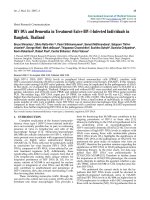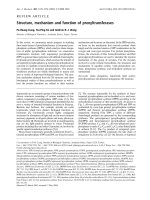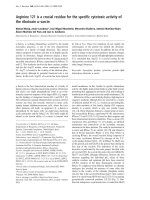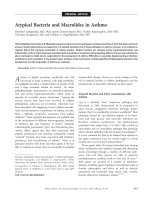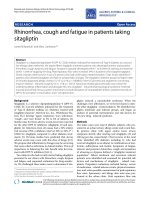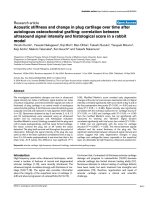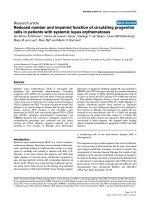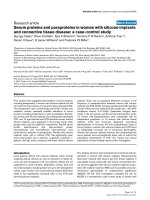Báo cáo y học: "Leukocyte numbers and function in subjects eating n-3 enriched foods: selective depression of natural killer cell levels" potx
Bạn đang xem bản rút gọn của tài liệu. Xem và tải ngay bản đầy đủ của tài liệu tại đây (760.72 KB, 11 trang )
Open Access
Available online />Page 1 of 11
(page number not for citation purposes)
Vol 10 No 3
Research article
Leukocyte numbers and function in subjects eating n-3 enriched
foods: selective depression of natural killer cell levels
Violet R Mukaro
1,3
, Maurizio Costabile
1,3
, Karen J Murphy
2
, Charles S Hii
1,4
, Peter R Howe
2
and
Antonio Ferrante
1,3,4
1
Department of Immunopathology, Children, Youth and Women's Health Service, 72 King William Road, North Adelaide SA 5006, Australia
2
Nutritional Physiology Research Centre, School of Health Sciences, University of South Australia, Adelaide SA 5000, Australia
3
School of Pharmaceutical and Medical Sciences, University of South Australia, Australia, Adelaide SA 5000, Australia
4
Discipline of Paediatrics, University of Adelaide, 72 King William Road, North Adelaide SA 5006, Australia
Corresponding author: Antonio Ferrante,
Received: 25 Feb 2008 Revisions requested: 14 Mar 2008 Revisions received: 18 Mar 2008 Accepted: 14 May 2008 Published: 14 May 2008
Arthritis Research & Therapy 2008, 10:R57 (doi:10.1186/ar2426)
This article is online at: />© 2008 Mukaro et al.; licensee BioMed Central Ltd. This is an open access article distributed under the terms of the Creative Commons Attribution
License ( which permits unrestricted use, distribution, and reproduction in any medium, provided the
original work is properly cited.
Abstract
Introduction While consumption of omega-3 long-chain
polyunsaturated fatty acids (n-3 LCPUFA) has been
recommended for those at risk of inflammatory disease such as
rheumatoid arthritis, the mechanism of their anti-inflammatory
effect remains to be clearly defined, particularly in relation to the
dose and type of n-3 LCPUFA. The objective of this study was
to determine whether varying the levels of n-3 LCPUFA in
erythrocyte membrane lipids, following dietary supplementation,
is associated with altered numbers and function of circulating
leukocytes conducive to protection against inflammation.
Methods In a double-blind and placebo-controlled study, 44
healthy subjects aged 23 to 63 years consumed either standard
or n-3 LCPUFA-enriched versions of typical processed foods,
the latter allowing a target daily consumption of 1 gram n-3
LCPUFA. After six months, peripheral blood leukocyte and
subpopulation proportions and numbers were assessed by flow
cytometry. Leukocytes were also examined for
lymphoproliferation and cytokine production, neutrophil
chemotaxis, chemokinesis, bactericidal, adherence and
iodination activity. Erythrocytes were analyzed for fatty-acid
content.
Results Erythrocyte n-3 LCPUFA levels were higher and
absolute leukocyte and lymphocyte numbers were lower in
subjects consuming n-3 enriched foods than in controls. There
were no changes in the number of neutrophils, monocytes, T
cells (CD3
+
), T-cell subsets (CD4
+
, CD8
+
) and B cells
(CD19
+
). However, natural killer (NK) (CD3
-
CD16
+
CD56
+
) cell
numbers were lower in n-3 supplemented subjects than in
controls and were inversely related to the amount of
eicosapentaenoic acid or docosahexaenoic acid in erythrocytes.
No significant correlations were found with respect to
lymphocyte lymphoproliferation and production of IFN-γ and IL-
2, but lymphotoxin production was higher with greater n-3
LCPUFA membrane content. Similarly, neutrophil chemotaxis,
chemokinesis, bactericidal activity and adherence did not vary
with changes in erythrocyte n-3 LCPUFA levels, but the
iodination reaction was reduced with higher n-3 LCPUFA
content.
Conclusion The data show that regular long-term consumption
of n-3 enriched foods leads to lower numbers of NK cells and
neutrophil iodination activity but higher lymphotoxin production
by lymphocytes. These changes are consistent with decreased
inflammatory reaction and tissue damage seen in patients with
inflammatory disorders receiving n-3 LCPUFA supplementation.
Introduction
There is evidence from both experimental models and clinical
studies that long-chain omega-3 polyunsaturated fatty acids
(n-3 LCPUFA) are beneficial in the treatment of autoimmune
and allergic inflammatory conditions [1-4]. Counterbalancing
n-6 fatty-acid intake with n-3 fatty acids is important because
n-6 fatty acids, such as arachidonic acid (AA) are released
during cellular activation and inflammation and metabolized to
generate highly inflammatory metabolites such as the 4-series
leukotrienes and 2-series prostaglandins [5-7]. Increasing the
n-3 LCPUFA = omega-3 long-chain polyunsaturated fatty acids; AA = arachidonic acid; EPA = eicosapentaenoic acid; DHA = docosahexaenoic acid;
MNL = mononuclear cells; NK cells = natural killer cells.
Arthritis Research & Therapy Vol 10 No 3 Mukaro et al.
Page 2 of 11
(page number not for citation purposes)
amounts of eicosapentaenoic acid (EPA) in membrane phos-
pholipids not only reduces the level of AA available for metab-
olism by the lipoxygenases and cyclooxygenases, but EPA
also competes against AA for metabolism to form metabolites
of the 5-series leukotrienes and 3-series prostaglandins,
which are significantly less pro-inflammatory than the AA-
derived metabolites, thereby taming the inflammatory reaction
[4].
The effects of n-3 LCPUFA supplementation on inflammation
and immune responses have been extensively studied [8]. This
includes the benefits in treating patients with rheumatoid
arthritis (RA), Crohn's disease, ulcerative colitis, systemic
lupus erythematosus, psoriasis, atherosclerosis and asthma
[9]. Despite the finding of such beneficial effects there is still
insufficient evidence to enable specific recommendations to
be made on the use of n-3 fats in these disorders [10]. These
include knowledge of efficacious doses of n-3 fatty acids and
the type of n-3 fat that is most effective. The evidence indi-
cates that EPA and docosahexaenoic acid (DHA) have differ-
ential effects which may be further complicated by the array of
immune cells and pathways which can be altered by these
PUFAs [5]. This would explain the variation from study to study
in the degree of benefit attained for different conditions.
Here we examine the effects of providing low-dose long-term
n-3 fatty acids in foods on a number of parameters of innate
and adaptive immune response. We also took this opportunity
to explore the relationship between membrane fatty-acid com-
position and several components of the immune system rele-
vant to inflammatory diseases such as RA by analyzing
leukocyte levels and functional responses in blood samples
obtained from subjects receiving n-3 LCPUFA supplementa-
tion in a 6-month intervention trial. The results showed that a
higher level of n-3 LCPUFA in erythrocyte membrane phos-
pholipids is associated primarily with a significantly lower
number of circulating natural killer (NK) cells, which could be
considered beneficial in reducing tissue damage in chronic
inflammatory diseases.
Materials and methods
Ficoll 400 was obtained from Pharmacia Biotech (Uppsala,
Sweden). RPMI 1640 medium and glutamine were obtained
from JRH Biosciences (Lenexa, KA). Sodium diatrizoate,
DMSO, N-formyl-methionyl-L-leucyl-L-phenyalanine (fMLP),
Rose Bengal stain (0.25 % w/v in phosphate-buffered saline
(PBS) with Ca
2+
, Mg
2+
), zymosan and 3,3',5,5'-tetramethyl-
benzidine were purchased from Sigma (St Louis, MO). Angi-
ograffin was obtained from Schering (Leverkusen, Germany).
Agarose was purchased from Calbiochem (La Jolla, CA).
Tumor necrosis factor (TNF) was obtained from the Ernst-Boe-
hringer Ingelheim Institut (Vienna, Austria). The Staphylococ-
cus aureus strain NCTC 6571, for measuring neutrophil
bactericidal activity, was obtained from the National Centre for
Tissue Cultures (Oxford, UK).
125
I in the form of NaI and
[H
3
]thymidine was purchased from Amersham International
(Little Chalfont, UK). All monoclonal antibodies for the determi-
nation of lymphocyte subsets, IgG1 isotype control antibody
and Simultest IMK kit were obtained from BD Biosciences
(San Jose, CA). Phytohemagglutinin (PHA) was obtained from
Murex Diagnostics (Dartford, UK). Anti-human interferon-γ
(IFNγ) coating monoclonal antibody and anti-human inter-
leukin-2 (IL-2) polyclonal antibody were purchased from
Endogen (Rockford, IL). The biotin-labeled anti-human IFNγ
and anti-human IL-2-detecting monoclonal antibodies, horse-
radish peroxidase, streptavidin and quality-control sample for
IFNγ were also purchased from Endogen. The anti-human lym-
photoxin (LT) coating and biotin-labeled anti-human LT-detect-
ing monoclonal antibodies were purchased from R&D
Systems (Minneapolis, MN). The quality-control samples for
LT and IL-2 and standards for IFNγ were obtained from the
National Institute for Biological Standards and Control (South
Mimms, UK). The standards for LT were purchased from Bio-
source International (Camarillo, CA). The standards for IL-2
were purchased from Hazelton Biotechnologies (Vienna, Aus-
tria).
Study foods
A range of study foods including pancake mix, bread, milk,
margarine, eggs, chocolate, soup mix, dips, instant oats,
cheese spread, muffin mix, biscuits and salad dressing were
provided by Goodman Fielder (Sydney, Australia). Foods were
either enriched with n-3 LCPUFA from microencapsulated
cod liver oil (Maritex, Aarhus, Denmark) (n-3 supplemented) or
were devoid of n-3 LCPUFA (placebo). The fatty-acid compo-
sition of the study foods is described elsewhere [10,11]. Each
enriched food portion provided 125 mg EPA + DHA and sub-
jects were asked to consume eight exchanges daily, to equal
1 g n-3 PUFA/day. Subjects were matched for gender and age
then randomly allocated to treatment or control groups. Die-
tary interviews were conducted by trained dieticians using diet
questionnaires and food records as described by Patch et al.
[10] to score the acceptability and palatability of individual
food items to ensure compliance with test foods. Subjects
were encouraged to keep 'diet diaries' in order to monitor the
amount of n-3 PUFA-rich foods consumed. The target macro-
nutrients intakes (% of energy) were as follows: 20% protein,
50% carbohydrate, 30% fat (polyunsaturated: mono-unsatu-
rated: saturated = 1:1:1) [11].
Subjects and study design
A double-blind, placebo-controlled dietary intervention study
of 6 months duration was approved by the Human Research
Ethics Committees of the University of Adelaide and the Com-
monwealth Scientific and Industrial Research Organization
(CSIRO) (see Murphy et al. [11] for details). The trial com-
menced in 2003 and consent from the subjects recruited was
obtained. Forty-four non-smoking volunteers aged 20 to 65
years, who were overweight (BMI > 25 kg/m
2
) and had fasting
plasma triacylglycerol > 1.6 mmol/l, but were otherwise
Available online />Page 3 of 11
(page number not for citation purposes)
healthy, were recruited from the general community through
media advertisements. Volunteers were excluded if they were
taking non-steroidal anti-inflammatories, antihypertensives,
lipid-lowering or other drugs affecting lipid metabolism. Other
exclusion criteria include the consumption of more than one
fish meal per week, regularly taking fish oil supplements, ina-
bility to consume test foods, recent (previous 3 months) diag-
nosis of diabetes, symptomatic heart disease, angina pectoris,
history of myocardial infarction or stroke, peripheral vascular
disease, liver or renal disease (plasma creatinine > 120 mmol/
l), major surgery, blood pressure (BP) > 170/100 mmHg; or
smokers and/or ex-smokers within the past two years.
Erythrocyte membrane fatty-acid composition
The fatty-acid composition was analyzed at 6 months as
described by Murphy et al. [11]. Erythrocytes were isolated,
lysed and the membrane lipids extracted into methanol: tolu-
ene (4:1, by volume) according to the method of Lepage and
Roy [12]. Fatty-acid methyl esters were analyzed by flame-ion-
ization gas chromatography (model GC-20A, Shimazdu Cor-
poration, Kyoto, Japan) using a 50-m BPX70 capillary column
(0.32 mm internal diameter and 0.25 μm film thickness (Scien-
tific Glass Engineering, Melbourne, Australia). Individual fatty
acids were identified by comparison with known fatty-acid
standards (Nuchek Prep, Elysian, MN) and expressed as a per-
centage of total fatty acids quantified from peak areas.
Preparation of peripheral blood mononuclear cells and
neutrophils
At the end of the 6-month trial, 10 ml blood was collected by
venepuncture after a 12-h overnight fast into lithium heparin
tubes. Mononuclear cells (MNL) and neutrophils were purified
by the rapid one-step procedure according to Ferrante and
Thong [13]. Briefly, heparinized blood was layered onto a den-
sity separation medium consisting of Ficoll 400-Hypaque,
density 1.114. Following centrifugation at 600 g for 35 min,
the MNL and neutrophil bands were harvested and washed
twice with RPMI 1640 medium by centrifugation (5 min × 600
g) and MNL resuspension in RPMI 1640 medium or neu-
trophils in Hanks Buffered Salt Solution (HBSS).
Neutrophil chemotaxis and chemokinesis
Neutrophils, 5 μl of 4 × 10
7
cells/ml, were allowed to migrate
under agarose for 90 min at 37°C/5% CO
2
-air incubator as
previously described [14] in the presence of a chemotactic
gradient generated by 5 μl 10
-7
M of fMLP, or 5 μl of diluent
DMSO (1% v/v in PBS). The distance migrated by the cells
was expressed in mm/90 min. For chemokinesis, neutrophils
(20 μl; 4 × 10
7
/ml) were pre-incubated with 20 μl fMLP for 5
min at 37°C in a humidified CO
2
(5% CO
2
in air) incubator,
centrifuged in a microcentrifuge (30 sec × 1 g force), the
supernatant was removed and the cells resuspended in 20 μl
HBSS with phenol. The random migration in four directions –
top, bottom, left and right – was measured using an inverted
Leitz microscope. Chemokinesis was expressed as the mean
of the distance (in millimeters) traveled in the four directions.
Neutrophil adherence
Neutrophil adherence was assayed by measuring neutrophil
adherence to plasma-coated plastic surfaces [15]. To the 96-
well microtiter plates was added 250 μl/well of 10% autolo-
gous plasma and the plates were incubated for 30 min 37°C
in a humidified CO
2
(5% CO
2
in air) incubator. The plates were
subsequently washed with HBSS and air-dried. Then, 100 μl
of 5 × 10
6
neutrophils treated with either TNF or with HBSS
as a control were loaded into the wells and incubated for 30
min at 37°C in a CO
2
incubator. Non-adherent cells were
removed by inversion of plates and the wells washed three
times with HBSS. Adherent cells were stained with Rose Ben-
gal (0.25 % w/v in PBS with Ca
2+
, Mg
2+
) [14], washed and
the dye was then released by adding 50% ethanol and the
absorbance was read at 570 nm using a plate reader
(Dynatech MR7000, Dynatech Laboratories, Chantilly, VA).
The degree of adherence was calculated by subtracting the
mean absorbance values of blank wells from the mean of the
test wells.
Neutrophil bactericidal activity
The ability of neutrophils to kill Staphylococcus aureus was
assessed as described previously [16]. Neutrophils (1 × 10
6
cells) were mixed with 1 × 10
6
S. aureus in HBSS and 10%
(final) pooled human AB serum in tubes which were then
gassed with 5% CO
2
-air mixture and incubated with end-to-
end mixing at 37°C. Samples were taken at 0, 1 and 2 h,
diluted in sterile distilled water and plated onto blood agar for
colony growth and enumeration of the number of surviving
bacteria.
Neutrophil iodination reaction
The quantitative neutrophil iodination reaction, which exam-
ines the ability to produce oxygen radicals and the release of
myeloperoxidase enzyme, was determined by the method
described by Thong and Ferrante [17]. Briefly, 25 μl of
125
I
(200 μCi/ml) was added to 1 ml pooled human serum (1:4
dilution in HBSS) and 25 ml added to appropriate wells in a
96-well microtiter plate. Six wells were used for either pooled
serum or autologous serum, three of which were stimulated
with 50 μl zymosan. As a control, 50 μl of HBSS was added
to the remaining three. The plates were incubated for 30 min
at 37°C in a humidified CO
2
(5% CO
2
in air) and then 50 μl of
1 × 10
7
neutrophils/ml were added to appropriate wells. The
plates were covered and incubated for 90 min. Finally, the
cells were harvested using a cell harvester (Titertek Cell Har-
vester 550) and the quantity of bound
125
I was expressed as
picomoles/10
7
neutrophils. The amount of iodination due to
stimulation was calculated by subtracting the basal iodination
value (no zymosan added) from the stimulated iodination value
(plus zymosan).
Arthritis Research & Therapy Vol 10 No 3 Mukaro et al.
Page 4 of 11
(page number not for citation purposes)
Lymphocyte phenotyping and leukocyte numbers
Lymphocyte subpopulations were determined using a lym-
phocyte kit and direct two-color immunofluorescence. The kit
allows for determination of all T cells (CD3
+
/CD4
+
and CD3
+
/
CD8
+
), monocytes (CD16
+
), NK cells (CD3
-
/CD16
+/
56
+
) and
B lymphocytes (CD19
+
) in one sample simultaneously. One
hundred microliters of whole-blood samples were mixed with
2 ml of 1× lysing solution, vortexed and incubated for 10 min
at room temperature in the dark. Immediately after incubation
the tubes were centrifuged for 5 min at 300 g, the supernatant
was removed and the pellet resuspended in 2 ml Isoton II. The
cells were then centrifuged (300 g × 5 min), the supernatant
was removed and the pellet fixed in formaldehyde (200 μl 1%
solution). The fluorescence intensity was measured using a
flow cytometer (FACScan, BD Biosciences, NSW, Australia).
The data was processed with Lysis II software (BD Bio-
sciences). To determine leukocyte and lymphocyte numbers,
130 μl of whole blood was aspirated and analyzed using a
hematology analyzer CELL-DYN 3500SL (Abbott Diagnos-
tics, North Chicago, IL).
Measurement of lymphoproliferation
Mononuclear cells in samples of 100 μl (2 × 10
5
cells) were
cultured in medium supplemented with 4 mM L-glutamine
solution, 100 U/ml penicillin, 100 μg/ml streptomycin, 5%
human heat-inactivated AB serum and 100 μl PHA (2 μg/ml).
The final volume of the culture was 200 μl, and all cultures
were performed in triplicate as described previously [18]. Pro-
liferation was measured as the incorporation of [
3
H]thymidine
over the final 6 h of a 72-h culture period.
Measurement of cytokine production
Mononuclear cells were cultured in concentrations and condi-
tions as described above, the culture medium was removed
after 72 h and stored at -70°C for cytokine (LT, IL-2 and IFNγ)
analysis by enzyme-linked immunosorbent assay [18].
Statistical analysis
All statistical analyses were performed using GraphPad InStat
software. Data were analyzed as comparisons between pla-
cebo and n-3 PUFA-supplemented groups, as well as correla-
tions between the membrane fatty-acid levels and specific
immunological parameters. The Kolmogorov-Smirnov test was
used to determine normal distribution of data. Linear regres-
sion analyses were performed and statistical comparisons
were carried out using Student's two-tailed t-test for paired or
unpaired data and p < 0.05 was considered significant.
Results
Erythrocyte membrane fatty-acid composition
A total of 42 (21 placebo and 21 supplemented) individuals
completed the study; however, a few samples were not viable
and/or were lost, thus accounting for the variation in sample
numbers. Analysis of the erythrocyte membrane lipid composi-
tion (n = 18 placebo and n = 20 n-3 LCPUFA supplemented)
Figure 1
Levels of n-3 fatty acids in membrane phospholipids of erythrocytesLevels of n-3 fatty acids in membrane phospholipids of erythrocytes. (a)
Eicosapentaeonic acid (EPA), (b) docosahexaenoic aid (DHA) and (c)
n-3 LCPUFA (EPA + docosapentaenoic acid (DPA) + DHA) in the pla-
cebo and supplemented groups. Blood was taken after 6 months and
analyzed for fatty-acid composition as outlined in Materials and meth-
ods. Data are expressed as mean ± SEM; n = 18 for the placebo group
and n = 20 for the supplemented group. ***p < 0.0001, Student t-test.
Available online />Page 5 of 11
(page number not for citation purposes)
showed considerable overlap in levels of n-3 and n-6 PUFA,
EPA and DHA between the two groups (Figure 1). The EPA,
DHA and total n-3 LCPUFA (docosapentaenoic acid (DPA) +
EPA + DHA) content in the enriched group was significantly
higher than in the placebo group (Figure 1), whereas the total
n-6 LCPUFA content was higher in the placebo group than in
the supplemented groups (data not shown) 24.8 ± 0.23 %
and 22.65 ± 0.31% respectively (p < 0.0001).
Alteration in leukocyte levels
Total leukocyte levels were significantly lower in n-3-supple-
mented subjects than in controls (Figure 2a). This difference
was reflected in total lymphocytes (Figure 2b). Linear regres-
sion for lymphocyte numbers versus percentage of plasma
membrane fatty acid showed a significant negative correlation
with EPA levels (Table 1). The correlation with DHA and total
n-3 LCPUFA, though not significant, showed the same trend
of decreasing lymphocyte numbers with higher membrane n-3
LCPUFA content.
Comparing the data between the n-3 LCPUFA supplemented
and the placebo group with respect to levels of other leuko-
cyte subpopulations showed that there was no significant dif-
ference in CD3
+
, CD4
+
, CD8
+
, and CD19
+
cells (Table 2).
Similarly there was no significant negative correlation between
the amount of membrane n-3 LCPUFA, EPA and DHA in eryth-
rocytes and the levels of these leukocyte subpopulations
(Table 1). However, the number of NK cells was significantly
lower with n-3 LCPUFA supplementation (Figure 2c). Regres-
sion analysis showed a significant negative correlation
between the number of CD16
+
/CD56
+
cells and amounts of
EPA, DHA and total n-3 LCPUFA (Figure 3). The data show
that with higher n-3 PUFA content there are fewer NK cells. In
comparison, when NK cells were correlated with the total
amount of n-6 PUFA, which decreased in the supplemented
group compared with the placebo, as demonstrated above,
there was a positive correlation (r = 0.34; p < 0.05), higher
amounts of total n-6 PUFA were associated with higher NK-
cell levels (data not shown).
Lymphocyte function
There was no difference in the PHA-induced lymphocyte pro-
liferation in MNL from the n-3 LCPUFA-supplemented and pla-
cebo groups (Table 3). However, when relating the
proliferation response to the levels of n-3 LCPUFA in the
plasma membrane lipids, we demonstrated that the relation-
ship follows a curve (U-shaped) rather than a line (Figure 4).
Thus with higher membrane n-3 LCPUFA levels, PHA-induced
proliferation was initially lower but with further increases in n-
3 LCPUFA content proliferation increased.
The production of IFNγ and IL-2 by MNL stimulated by PHA
was not significantly different between the n-3 LCPUFA sup-
plemented and placebo groups (Table 3). Furthermore, there
was no correlation between the membrane n-3 LCPUFA and
Figure 2
Effect of n-3 LCPUFA supplementation on leukocyte numbersEffect of n-3 LCPUFA supplementation on leukocyte numbers. Number
of (a) total white cells, (b) lymphocytes and (c) NK cells
(CD16
+
CD56
+
) for the placebo and n-3 supplemented groups. Blood
was taken after 6 months and white-cell enumeration carried out as out-
lined in Materials and methods. Data are expressed as mean ± SEM. *p
< 0.05, significance of difference between placebo and supplemented
(Student t-test). n = 19 for both placebo and supplemented groups.
Arthritis Research & Therapy Vol 10 No 3 Mukaro et al.
Page 6 of 11
(page number not for citation purposes)
ability to produce cytokine (Table 1). In contrast, LT production
by PHA-stimulated MNL was much greater in the n-3-supple-
mented group compared with placebo (Figure 5) and showed
a significant and positive correlation with EPA erythrocyte con-
tent (Table 1, Figure 5).
Neutrophil functions
When comparing the neutrophil functional responses
between n-3 LCPUFA-supplemented subjects and placebo,
we found no significant differences in chemotaxis, chemokine-
sis, adherence and bactericidal activity (Table 4), and no sig-
nificant differences between the n-3 LCPUFA levels in the
erythrocyte membrane and all these functions, apart from the
neutrophil iodination reaction (Table 5). The iodination
response showed a 'bell-shaped' relationship when analyzed
against the EPA and DHA content of erythrocyte membranes
(Figure 6). This shows that there is greater iodination reaction
with higher n-3 LCPUFA content. However, with further
increases in n-3 LCPUFA levels, the neutrophil iodination
activity was lower.
Discussion
The data showed that in association with an increase in con-
sumption of n-3 LCPUFA there was a significant reduction in
levels of circulating NK cells (CD16
+
CD56
+
). Comparisons
between the supplemented and placebo group indicate that n-
3 LCPUFA reduces NK-cell numbers in the circulation. Analy-
sis of the NK-cell levels against the amount of n-3 LCPUFA in
the erythrocyte membranes established a negative correlation
with the level of EPA, DHA and total n-3 LCPUFA. A linear cor-
relation was seen over the n-3 LCPUFA range of 6.68 to
12.05%. A similar correlation was seen over the EPA range of
0.48 to 1.65% and DHA of 3.61 to 8.04%. The reduced NK-
cell numbers can only be contributing in a very small way to the
reduced levels of total leukocytes and lymphocytes seen over
this range of n-3 LCPUFA, EPA and DHA levels. While we also
Table 1
Regression analysis of membrane n-3 LCPUFA content versus lymphocyte subpopulation
a
numbers and cytokine production
EPA DHA n-3 LCPUFA
c
r
b
p value
b
rp value rp value
CD3
+
-0.32 0.07 -0.06 0.74 -0.20 0.27
CD4
+
-0.34 0.06 -0.04 0.84 -0.19 0.28
CD8
+
-0.17 0.36 -0.07 0.70 -0.12 0.50
CD4
+
:CD8
+
0.14 0.45 0.01 0.94 0.06 0.73
CD16
+
CD56
+
-0.39
d
0.025 -0.37 0.033 -0.38 0.029
CD19
+
-0.13 0.47 -0.11 0.56 -0.12 0.50
IFNγ 0.17 0.43 0.13 0.56 0.16 0.50
IL-2 0.23 0.30 0.23 0.30 0.26 0.24
LT 0.43 0.046 0.18 0.44 0.27 0.22
Lymphocytes -0.45 0.009 -0.21 0.25 -0.28 0.11
Neutrophils -0.24 0.18 -0.31 0.065 -0.31 0.078
Monocytes 0.06 0.80 0.41 0.11 0.28 0.27
Total leukocytes -0.33 0.06 -0.32 0.07 -0.34 0.06
a
CD3
+
, all circulating T cells; CD4
+
, all T helper cells; CD8
+
, all cytotoxic T cells; CD19
+
, all B lymphocytes; CD16
+
CD56
+
, all NK cells; IFNγ,
interferon-gamma; IL-2, interleukin 2; LT, lymphotoxin.
b
The correlation coefficient r value; the p value shows the significance (p < 0.05) (ANOVA)
of the obtained r value.
c
n-3 LCPUFA refers to the sum of docosapentaenoic acid (DPA), eicosapentaenoic acid (EPA) and docosahexaenoic acid
(DHA).
d
Boldfaced text shows results with r value of p < 0.05.
Table 2
Effect of 6 months of supplementation with n-3 enriched foods on absolute numbers of other leukocyte subpopulations
Group
a
CD3 CD4 CD8 CD19 Neutrophils Monocytes
Placebo 1.64 ± 0.12
b
1.05 ± 0.09 0.59 ± 0.07 0.21 ± 0.02 3.51 ± 0.19 0.25 ± 0.03
n-3 supplemented 1.47 ± 0.09 0.95 ± 0.07 0.53 ± 0.04 0.18 ± 0.02 3.04 ± 0.13 0.22 ± 0.02
a
CD3, all circulating T-cells; CD4, all T helper cells; CD8, all cytotoxic T cells; CD19, all B lymphocytes.
b
Data are presented as cells/l (× 10
9
)
mean ± SEM (n = 16 to 17).
Available online />Page 7 of 11
(page number not for citation purposes)
observed lower levels of neutrophils, T cells, B cells and T-cell
subpopulations, this was not significant. This suggests that
NK cells are most sensitive to increasing amounts of n-3 LCP-
UFA. Previously, others have reported that n-3 PUFA supple-
mentation leads to reduced NK activity. Thies et al. [19]
reported that only a moderate intake of EPA + DHA (720 mg
+ 280 mg)/day (but not DHA alone), α-linolenic (18:3n-3) or
γ-linolenic acid (18:3n-6) over a 12-week period caused a
reduction in NK-cell activity. No corresponding decrease in
numbers or proportions of NK cells was observed. As our
studies demonstrated that reduced levels are associated with
greater amounts of n-3 LCPUFA in cell membranes, it is likely
that the difference is related to the duration of the supplemen-
tation period. In fact our observations at 12 weeks of supple-
mentation revealed that NK-cell numbers were not significantly
correlated with n-3 LCPUFA levels in erythrocyte membranes
(data not shown). Kelley et al. [20] reported a reduction in NK-
cell activity using 6 g DHA/day over 12 weeks and this was
also associated with an increase in DHA (2.3 to 7.4% of total
fatty acids) in MNL. However, the NK-cell numbers or propor-
tions were not measured. More recently, Miles et al. [21]
reported that supplementation with 4 g/day of EPA had little
effect on the magnitude of NK-cell activity. We now report that
a major consequence of increasing cell membrane levels of n-
3 LCPUFA is a correlated decrease in NK-cell numbers. Col-
lectively, the above studies suggest that under appropriate n-
3 PUFA enrichment, both NK-cell numbers and NK-cell activity
are reduced.
While NK cells are important in immune surveillance, particu-
larly against viral infections and cancer [22-24], the cells are
also likely to play a role in the pathogenesis of inflammatory
diseases as they have the ability to produce high levels of the
pro-inflammatory cytokines IFN-γ, IL-1 and TNF, and are cyto-
toxic for tissues. For example, decreased NK-cell activity has
been implicated as a protective mechanism of n-3 LCPUFA
(EPA and DHA) in patients with ulcerative colitis [25]. Aaskov
et al. [26] reported that NK cells from patients with epidemic
polyarthritis could lyse autologous synovial cells and hence
contribute to the arthritis. The ability of n-3 LCPUFA to reduce
circulating NK-cell numbers could be another way in which n-
3 LCPUFA protect against these inflammatory disorders, act-
ing in concert with the established dogma that n-3 LCPUFA
reduce the levels of potent pro-inflammatory eicosanoids [9].
Our findings also raise the possibility that n-3 LCPUFA may
protect during infection-induced exacerbation of tissue dam-
age in RA patients through an effect on NK-cell levels.
Whether or not the NK cells in our studies were also less cyto-
toxic remains to be established, but on the basis of previous
reports this is likely and would add to the anti-inflammatory
effects, which our findings support. The basis for the reduced
NK-cell numbers will need to be further studied. However, it is
likely to be related to an effect on hematopoiesis, perhaps
selectively affecting NK-cell development.
Figure 3
Relationship between NK-cell numbers and erythrocyte membrane lip-idsRelationship between NK-cell numbers and erythrocyte membrane lip-
ids. (a) Eicosapentaenoic acid (EPA), (b) docosahexaenoic acid
(DHA), and (c) total n-3 LCPUFA (EPA + DPA + DHA) after 6 months
of supplementation; n = 33. CD16
+
CD56
+
, NK cells.
Arthritis Research & Therapy Vol 10 No 3 Mukaro et al.
Page 8 of 11
(page number not for citation purposes)
Earlier studies, which examined the effects of dietary supple-
mentation with n-3 LCPUFA on immune function, in most
cases used daily doses as high as 5.4 g and, not surprisingly,
demonstrated a marked suppression of immunological
responses such as neutrophil chemotaxis, MNL cytokine pro-
duction and lymphocyte proliferation [27-29]. Another study,
which used high doses of n-3 LCPUFA, (14.4 g per day over
10 weeks) reported a large reduction in neutrophil chemotaxis
(93%) [27]. It is usually accepted that depressed neutrophil
functions are not seen at lower doses such as those used in
our study.
At these lower doses we found very little effect on lymphocyte
function. There was no difference in lymphocyte proliferation
to PHA between the n-3 LCPUFA-supplemented and placebo
groups. This contrasted with the observations of the produc-
tion of cytokines by T cells. Whereas there was no significant
difference between the two groups in the production of IL-2
and IFNγ, LT production was increased in the n-3 LCPUFA-
supplemented group compared with placebo at 6 months.
However, the PHA-induced proliferation exhibited a U-shaped
relationship with the increases in n-3 LCPUFA content. This
effect of PHA-induced proliferation was somewhat mirrored in
the production of PHA-induced LT. Regression analysis
showed a positive correlation between the LCPUFA levels in
erythrocyte membranes and LT production by lymphocytes.
The discrepancy in the pattern of regression – that is, linear in
the case of LT or U-shaped in that of PHA-induced prolifera-
tion – suggests that the proliferation response is more com-
plex in terms of sensitivity to the membrane content of fatty
acids compared to the production of LT. It remains to be
established why low-dose n-3 LCPUFA supplementation pro-
motes production of LT but not the other T-cell cytokines, IFNγ
and IL-2. Nevertheless, such increases in LT production can
be protective against tissue damage in RA. It has been dem-
onstrated that, unlike TNF, IFNγ and IL-2, which augment neu-
trophil-mediated inhibition of cartilage proteoglycan synthesis,
LT markedly depressed this activity [30]. Others have shown
that with increases in dose of EPA there is greater production
of the anti-inflammatory cytokine IL-4 [21].
Neutrophil functions, chemotaxis, chemokinesis, adhesion and
bactericidal activity were unaffected by n-3 LCPUFA supple-
mentation. Our finding of bell-shaped relationships for the iodi-
nation activity may also be of importance in protection against
tissue damage in RA. The iodination reaction is a measure of
the production of hypochlorous acid by neutrophils through
the generation of H
2
O
2
and release of myeloperoxidase [31].
Interestingly this system was found to be important for articular
cartilage damage by neutrophils [30].
Analyses of the relationship between membrane LCPUFA pro-
files and the content and immune function of peripheral blood
leukocytes has been previous examined in non-supplemented
subjects [32], who would be expected to have lower n-3 LCP-
UFA levels than our study subjects who received n-3 LCPUFA
supplementation. Kew et al. [32] reported that DHA was pos-
itively correlated with neutrophil, monocyte and lymphocyte
responsiveness. This relationship was maintained even with
AA, although there was a negative correlation with the n-6:n-3
ratio. This may be different when the higher levels attained with
n-3 supplementation are taken into consideration. As Kew et
al. [32] indicated in their studies, there might be a bell-shaped
relationship between functional activity of leukocytes and
LCPUFA concentration. Indeed, this was evident in the current
study where n-3 supplementation was used. Others have
reported a U-shaped correlation between doses of fish oil sup-
plementation (0.3, 1.0 and 2.0 g/day) and leukocyte function
[33].
Our approach was to analyze the immune parameters against
the corresponding LCPUFA level in erythrocyte membrane lip-
ids of the individual subject. These levels can be related to
supplementation doses and also serve to overcome some lim-
itations associated with compliance and various confounding
factors. It is also apparent that n-3 LCPUFA levels in plasma,
erythrocytes and leukocytes can be correlated. Thus changes
in levels of EPA and DHA in erythrocytes and leukocytes
appear to correlate during n-3 LCPUFA supplementation
[34,35], although the rate of incorporation between these cell
types is different in the first 6 to 12 weeks of supplementation.
Leukocytes, especially neutrophils, are likely to undergo some
activation or stimulation during purification and thus the fatty-
acid content may not be a reflection of the amount in the unac-
tivated state, possibly explaining some of the controversies in
findings by different laboratories. Thus the measurements in
erythrocytes may be a more reliable marker for routine testing
than those in leukocytes, although inevitably the latter are
required to delineate the mechanisms involved. While future
studies should consider the relationship between the cell type
Table 3
Effect of 6 months of supplementation with n-3 enriched foods on PHA-induced cytokine production and proliferation in peripheral
blood mononuclear leukocytes
Group IL-2
a
IFNγ
a
PHA proliferation
b
Placebo 1.83 ± 0.61 39.77 ± 12.53 193800 ± 20840
n-3 supplemented 4.01 ± 1.73 57.24 ± 11.62 191100 ± 19520
IL-2, interleukin 2; IFNγ, interferon-gamma; PHA, phytohaemagglutinin.
a
Cytokine data are presented as ng/ml, mean ± SEM (n = 9 to 13).
b
Proliferation data expressed in disintegration per minute (dpm).
Available online />Page 9 of 11
(page number not for citation purposes)
being examined and levels within that cell, this then becomes
a complex question, as leukocytes consist of subpopulations
of different cell types.
While the lower number of NK cells associated with low-dose
long-term n-3LCPUFA supplementation is likely to be benefi-
cial to patients with inflammatory disorders, it is also evident
that individuals consuming these fatty acids may have greater
susceptibility to viral infections. NK cells provide a first-line
defense against these pathogens [36]. It is, however, reassur-
ing that at these lower doses of supplementation, most com-
Figure 5
Effect of n-3 LCPUFA supplementation on the production of lympho-toxin (LT)Effect of n-3 LCPUFA supplementation on the production of lympho-
toxin (LT). (a) Peripheral blood mononuclear leukocytes were incubated
with PHA and the production of LT was determined after 72 h incuba-
tion. *p < 0.05, significance of difference between placebo and supple-
mented (Student t-test). Data are expressed as mean ± SEM; n = 9 for
the placebo group and n = 13 for the supplemented group. (b) Rela-
tionship between LT production and erythrocyte membrane eicosapen-
taenoic acid (EPA) after 6 months supplementation.
Figure 4
Relationship between PHA-induced proliferation in peripheral blood mononuclear cells and the n-3 LCPUFA content of erythrocyte mem-branesRelationship between PHA-induced proliferation in peripheral blood
mononuclear cells and the n-3 LCPUFA content of erythrocyte mem-
branes. Proliferation was measured by incorporation of [
3
H]thymidine
(
3
H-TdR). There was a significant correlation between [
3
H]thymidine
incoporation and (a) DHA and (b) total n-3 LCPUFA (EPA + DPA +
DHA) following a curve (p < 0.05; n = 31).
Arthritis Research & Therapy Vol 10 No 3 Mukaro et al.
Page 10 of 11
(page number not for citation purposes)
ponents of the innate and adaptive immune response were not
affected over the long term.
Conclusion
The approach reported here illustrates the importance of relat-
ing immune parameters to the levels of erythrocyte membrane
PUFA composition to establish a biochemical basis for
endeavors to supplement people with n-3 LCPUFA using
functional foods. It is thus tempting to suggest that such meas-
urements could be used as indices for predictions of protec-
tion against inflammation, and as a way of controlling the level
of n-3 LCPUFA supplementation. Furthermore, of all the
immune parameters measured, NK cells were the most sensi-
tive to the effects of increasing amounts of n-3 LCPUFA in the
diet. This is conducive to n-3 LCPUFA supplementation reduc-
ing cellular inflammation and tissue damage in diseases such
as RA. Future studies designed to elucidate the basis for the
reduced numbers of NK cells could give us new directions for
the use of n-3 LCPUFA supplementation.
Competing interests
The authors declare that they have no competing interests.
Figure 6
Relationship between neutrophil quantitative iodination reaction and the n-3 LCPUFA content of erythrocyte membranesRelationship between neutrophil quantitative iodination reaction and
the n-3 LCPUFA content of erythrocyte membranes. There was a signif-
icant correlation between the iodination activity and (a) EPA and (b)
DHA following a curve (p < 0.05; n = 23).
Table 4
Effect of 6 months of supplementation with n-3 enriched foods on neutrophil functions
Group Adherence
a
Bactericidal
b
Chemokinesis
c
Chemotaxis
c
Iodination
d
Placebo 0.36 ± 0.10 95.4± 0.52 0.76 ± 0.09 1.94 ± 0.092 7.93 ± 0.98
n-3 supplemented 0.29 ± 0.058 97.1 ± 0.63 0.76 ± 0.0356 1.91 ± 0.07 8.03 ± 0.65
Data are presented as mean ± SEM (n = 16 to 17).
a
Adherence expressed as relative absorbance at 570 nm.
b
Bactericidal activity expressed as % killing.
c
Chemokinesis and chemotaxis expressed in mm/90 min.
d
Iodination expressed in pmoles iodine/10
7
cells.
Table 5
Regression analysis of membrane n-3 LCPUFA content versus
neutrophil function
Function EPA DHA n-3 LCPUFA
a
r
b
p value
b
rp value rp value
Adherence -0.09 0.73 -0.08 0.77 -0.072 0.79
Chemotaxis -0.11 0.62 -0.12 0.57 -0.12 0.58
Chemokinesis 0.20 0.38 0.13 0.55 0.23 0.30
Bactericidal 0.30 0.15 0.21 0.33 0.25 0.24
Iodination 0.04 0.86 0.04 0.86 0.01 0.95
a
n-3 LCPUFA refers to the sum of docosapentaenoic acid (DPA),
eicosapentaenoic acid (EPA) and docosahexaenoic acid (DHA).
b
The correlation coefficient r value; the p value shows the
significance (p < 0.05) (ANOVA) of the obtained r value.
Available online />Page 11 of 11
(page number not for citation purposes)
Authors' contributions
VRM was responsible for conducting the immunology experi-
ments; KJM was responsible for conducting the fatty-acid
analyses. PRH and KJM were responsible for the organization
of the subjects and diet supplements. All authors participated
in study design, writing the manuscript and data analyses/
interpretation.
Acknowledgements
We are grateful to the staff of Department of Immunopathology at
CYWHS for assistance with the leukocyte assays. We thank Nancy
Briggs for assistance with the statistical analysis.
References
1. Kremer JM, Bigauoette J, Michalek AV, Timchalk MA, Lininger L,
Rynes RI, Huyck C, Zieminski J, Bartholomew LE: Effects of
manipulation of dietary fatty acids on clinical manifestations of
rheumatoid arthritis. Lancet 1985, 1:184-187.
2. Donadio JV Jr, Bergstralh EJ, Offord KP, Spencer DC, Holley KE:
A controlled trial of fish oil in IgA nephropathy. Mayo Nephrol-
ogy Collaborative Group. N Engl J Med 1994, 331:1194-1199.
3. Stamp LK, James MJ, Cleland LG: Diet and rheumatoid arthritis:
a review of the literature. Semin Arthritis Rheum 2005,
35:77-94.
4. Calder PC: n-3 polyunsaturated fatty acids, inflammation, and
inflammatory diseases. Am J Clin Nutr 2006, 83(6
Suppl):1505S-1519S.
5. Simopoulos AP: The importance of the ratio of omega-6/
omega-3 essential fatty acids. Biomed Pharmacother 2002,
56:365-379.
6. Wu D, Meydani SN: n-3 polyunsaturated fatty acids and
immune function. Proc Nutr Soc 1998, 57:503-509.
7. James MJ, Gibson RA, Cleland LG: Dietary polyunsaturated fatty
acids and inflammatory mediator production. Am J Clin Nutr
2000, 71(1 Suppl):343S-348S.
8. Simopoulos AP: Essential fatty acids in health and chronic dis-
ease. Am J Clin Nutr 1999, 70(3 Suppl):560S-569S.
9. Akabas SR, Deckelbaum RJ: Summary of a workshop on n-3
fatty acids: current status of recommendations and future
directions. Am J Clin Nutr 2006, 83(6 Suppl):1536S-1538S.
10. Patch CS, Tapsell LC, Mori TA, Meyer BJ, Murphy KJ, Mansour J,
Noakes M, Clifton PM, Puddey IB, Beilin LJ, Annison G, Howe PR:
The use of novel foods enriched with long-chain n-3 fatty acids
to increase dietary intake: a comparison of methodologies
assessing nutrient intake. J Am Diet Assoc 2005,
105:1918-1926.
11. Murphy KJ, Meyer BJ, Mori TA, Burke V, Mansour J, Patch CS,
Tapsell LC, Noakes M, Clifton PA, Barden A, Puddey IB, Beilin LJ,
Howe PR: Impact of foods enriched with n-3 long-chain poly-
unsaturated fatty acids on erythrocyte
n-3 levels and cardio-
vascular risk factors. Br J Nutr 2007, 97:749-757.
12. Lepage G, Roy CC: Direct transesterification of all classes of
lipids in a one-step reaction. J Lipid Res 1986, 27:114-120.
13. Ferrante A, Thong YH: Separation of mononuclear and poly-
morphonuclear leucocytes from human blood by the one-step
Hypaque-Ficoll method is dependent on blood column height.
J Immunol Methods 1982, 48:81-85.
14. Hii CS, Anson DS, Costabile M, Mukaro V, Dunning K, Ferrante A:
Characterization of the MEK5-ERK5 module in human neu-
trophils and its relationship to ERK1/ERK2 in the chemotactic
response. J Biol Chem 2004, 279:49825-49834.
15. Bates EJ, Ferrante A, Harvey DP, Poulos A: Polyunsaturated fatty
acids increase neutrophil adherence and integrin receptor
expression. J Leukoc Biol 1993, 53:420-426.
16. Ferrante A, Martin AJ, Bates EJ, Goh DH, Harvey DP, Parsons D,
Rathjen DA, Russ G, Dayer JM: Killing of Staphylococcus aureus
by tumor necrosis factor-alpha-activated neutrophils. The role
of serum opsonins, integrin receptors, respiratory burst, and
degranulation. J Immunol 1993, 151:4821-4828.
17. Thong YH, Ferrante A: A semi-automated microassay tech-
nique for quantitative leukocyte iodination. J Immunol Methods
1978, 20:297-299.
18. Costabile M, Hii CS, Melino M, Easton C, Ferrante A: The immu-
nomodulatory effects of novel beta-oxa, beta-thia, and
gamma-thia polyunsaturated fatty acids on human T lym-
phocyte proliferation, cytokine production, and activation of
protein kinase C and MAPKs. J Immunol 2005, 174:233-243.
19. Thies F, Nebe-von-Caron G, Powell JR, Yaqoob P, Newsholme EA,
Calder PC: Dietary supplementation with eicosapentaenoic
acid, but not with other long-chain n-3 or n-6 polyunsaturated
fatty acids, decreases natural killer cell activity in healthy sub-
jects aged > 55 y. Am J Clin Nutr 2001, 73:539-548.
20. Kelley DS, Taylor PC, Nelson GJ, Mackey BE: Dietary docosa-
hexaenoic acid and immunocompetence in young healthy
men. Lipids 1998,
33:559-566.
21. Miles EA, Banerjee T, Wells SJ, Calder PC: Limited effect of
eicosapentaenoic acid on T-lymphocyte and natural killer cell
numbers and functions in healthy young males. Nutrition
2006, 22:512-519.
22. Broek MF van den, Hengartner H: The role of perforin in infec-
tions and tumour surveillance. Exp Physiol 2000, 85:681-685.
23. Moretta A, Bottino C, Mingari MC, Biassoni R, Moretta L: What is
a natural killer cell? Nat Immunol 2002, 3:6-8.
24. Diefenbach A, Raulet DH: The innate immune response to
tumors and its role in the induction of T-cell immunity. Immu-
nol Rev 2002, 188:9-21.
25. Almallah YZ, El-Tahir A, Heys SD, Richardson S, Eremin O: Distal
procto-colitis and n-3 polyunsaturated fatty acids: the mecha-
nism(s) of natural cytotoxicity inhibition. Eur J Clin Invest 2000,
30:58-65.
26. Aaskov JG, Dalglish DA, Harper JJ, Douglas JF, Donaldson MD,
Hertzog PJ: Natural killer cells in viral arthritis. Clin Exp Immu-
nol 1987, 68:23-32.
27. Sperling RI, Benincaso AI, Knoell CT, Larkin JK, Austen KF, Robin-
son DR: Dietary omega-3 polyunsaturated fatty acids inhibit
phosphoinositide formation and chemotaxis in neutrophils. J
Clin Invest 1993, 91:651-660.
28. Lee TH, Hoover RL, Williams JD, Sperling RI, Ravalese J 3rd, Spur
BW, Robinson DR, Corey EJ, Lewis RA, Austen KF: Effect of die-
tary enrichment with eicosapentaenoic and docosahexaenoic
acids on in vitro neutrophil and monocyte leukotriene genera-
tion and neutrophil function. N Engl J Med 1985,
312:1217-1224.
29. Endres S, Ghorbani R, Kelley VE, Georgilis K, Lonnemann G, Meer
JW van der, Cannon JG, Rogers TS, Klempner MS, Weber PC, et
al.: The effect of dietary supplementation with n-3 polyunsatu-
rated fatty acids on the synthesis of interleukin-1 and tumor
necrosis factor by mononuclear cells. N Engl J Med 1989,
320:265-271.
30. Ferrante A, Kowanko IC, Bates EJ: Mechanisms of host tissue
damage by neutrophils activated by cytokines. In
Immunol Ser.
Volume 57. Edited by: Coffey R. New York: Marcel Dekker;
1992:499-521.
31. Ferrante A: Phagocytes Part 2: Neutrophils. In Topley and Wil-
son's Microbiology and Microbial Infections (Immunology) Edited
by: Kaufmann SH, Steward MW. London: Hodder Arnold;
2005:35-54.
32. Kew S, Banerjee T, Minihane AM, Finnegan YE, Williams CM, Cal-
der PC: Relation between the fatty acid composition of periph-
eral blood mononuclear cells and measures of immune cell
function in healthy, free-living subjects aged 25–72 y. Am J
Clin Nutr 2003, 77:1278-1286.
33. Trebble T, Arden NK, Stroud MA, Wootton SA, Burdge GC, Miles
EA, Ballinger AB, Thompson RL, Calder PC: Inhibition of tumour
necrosis factor-alpha and interleukin 6 production by mono-
nuclear cells following dietary fish-oil supplementation in
healthy men and response to antioxidant co-supplementation.
Br J Nutr 2003, 90:405-412.
34. Marangoni F, Angeli MT, Colli S, Eligini S, Tremoli E, Sirtori CR,
Galli C: Changes of n-3 and n-6 fatty acids in plasma and cir-
culating cells of normal subjects, after prolonged administra-
tion of 20:5 (EPA) and 22:6 (DHA) ethyl esters and prolonged
washout. Biochim Biophys Acta 1993, 1210:55-62.
35. Mu H, Thogersen RL, Maaetoft-Udsen K, Straarup EM, Frokiaer H:
Different kinetic in incorporation and depletion of n-3 fatty
acids in erythrocytes and leukocytes of mice. Lipids 2006,
41:749-752.
36. Lanier LL: Evolutionary struggles between NK cells and
viruses. Nat Rev Immunol 2008, 8:259-268.
